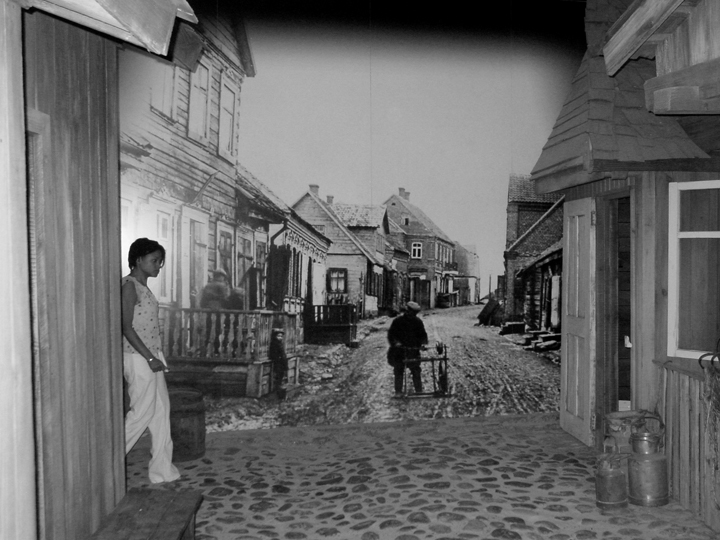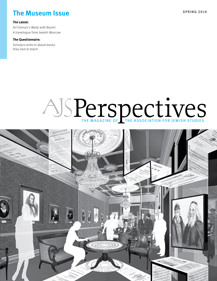
Attendees at the Jewish Museum's official opening in December 2000 included Nelson Mandela and Helen Suzman, a Jewish politician who gained fame for her resistance to Apartheid. How is the Jewish past and present in Southern Africa represented here? The point of departure is the community's own history signaled by the emblem of South Africa's oldest synagogue, an 1863 structure that, beginning in 1958, also housed the old Jewish Museum. Now the museum is integrated into the new architectural complex.
Inlaid into the floor at the building's center is a map of the world that contains a representation of the size of the various continents' Jewish population and demographic developments from 1881 to 2000. This depiction makes it clear that South Africa's 92,000 Jews—the figure has subsequently declined to an estimated 75,000—make up only a minute proportion of the country's 49 million inhabitants.
A featured attraction of the exhibit is what is said to be a typical eastern European shtetl, a diorama that could serve as the set for a production of the musical Fiddler on the Roof. The impression it makes is rather sterile and far removed from the poverty characteristic of real life in an actual shtetl. But how can poverty be portrayed in a way that does justice to reality? Dirt and mud, the smells, movements, and sounds can't be adequately expressed in a fictitious shtetl of this sort.
The museum's exhibits comprise a fascinating manifestation of the politics of historical remembrance, including a screening of a documentary film about Nelson Mandela entitled A Righteous Man. In addition to giving an account of Mandela's life, the film highlights Jewish activists' notable efforts in the struggle against Apartheid. Nevertheless this high level of commitment by no means garnered unanimous community approval during the Apartheid era, when many Jews feared making waves and attracting the spotlight of political attention. The film also touches upon the issue of collaboration with the Apartheid regime, staging an encounter between Nelson Mandela and Percy Yutar, prosecutor at Mandela's 1963 trial. Yutar was then the elected head of the Orthodox United Hebrew Congregation in Johannesburg. The dilemma is thus brought out clearly—after all, Mandela as an individual can obviously forgive or reconcile with some other individual, but what about the other victims of Apartheid who don't even know who bears the blame for their fate or that of their families? In any case, the museum has not yet complied with the demand by South African Jewish activists—first and foremost, Claudia Braude—that the community deal openly and critically with its past and especially its collaboration with the Apartheid system and the history of bilateral relations between Israel and the Apartheid regime.
The administratively independent Holocaust Centre that opened in 1999 seems, at first glance, to be oriented more to current issues relevant to South African historical memory. The origins of this museum and educational center are connected to the showing of the Anne Frank exhibition that ran for the first time in Africa during the phase of transition. The tremendous popular interest in this exhibition actually came as a bit of a surprise; one reason is undoubtedly the fact that The Diary of Anne Frank was one of the books available to the inmates of Robben Island prison near Cape Town. Attendance by Nelson Mandela and Archbishop Desmond Tutu at the exhibition's opening in Johannesburg on August 15, 1994, generated a great deal of publicity. On that occasion, Mandela stated: "During the many years my comrades and I spent in prison, we derived inspiration from the courage and tenacity of those who challenge injustice even under the most difficult circumstances. . . . Some of us read Anne Frank's Diary on Robben Island and derived much encouragement from it." (citation [August 5, 2009]). The big question is whether, from a South African perspective, establishing a connection to Anne Frank, a global icon of historical remembrance, can help to embed the fate of South Africa with respect to colonialism and racism into the global discourse of historical remembrance. If so, then this would also serve to help establish interest in the Holocaust and the process of dealing with it in South Africa and thus, for the first time, on the African continent as a whole.
The most interesting thing about the Cape Town Holocaust Centre is its effort to establish a historical comparison that transcends temporal and geographical differences between National Socialism and Apartheid. It was necessary for the Holocaust Centre to bring out parallels, because the overwhelming majority of visitors are non-Jewish and non-white, and about half are students, predominantly from impoverished areas who have never had personal contact with Jews.
The Holocaust Centre's permanent exhibition succeeds in establishing a relation between the Shoah and the history of Apartheid by drawing parallels between the Apartheid system and historical events before and after the Shoah. This is powerfully illustrated by the symbols of South African "apartness" in the public sphere such as separate stairways in train stations and especially park benches labeled "Whites Only." Juxtaposing these images to pictures of park benches in Nazi Germany reserved, respectively, for Aryans and for Jews makes it clear that the concrete connection between the two regimes was their racism that aimed to achieve separation and isolation. Another excellent example of this is the comparison of the Nuremberg racial laws with the Apartheid system's Immorality Act that prohibited mixed marriages and sexual contacts between whites and other South Africans. Indeed, the drawing of these parallels ends with the beginnings of the Nazis' systematic mass murder, and is not resumed until it comes to consideration of the post-Holocaust period and the question of how it is possible to come to terms with such horrific inhumanity in a way that does sociopolitical justice to it.
But a museum isn't just a location in which to represent a historical narrative that needs to be told. It's the presence of visitors that enables it to fulfill its mission—after all, without reception, representation would be senseless. About 25,000 people a year visit the Holocaust Centre; group reservations are booked up more than a year in advance. And there's a good reason for that: namely, the fact that Holocaust education—"The Holocaust and Human Rights"—has been a required part of South Africa's ninth grade social sciences (history) curriculum since 2007. In this connection, it's probably realistic to assume that many students and teachers haven't the slightest idea what the term Holocaust signifies, so that this amounts in one respect to a campaign of enlightenment under the motto "Teach the Teachers." It goes without saying that this is a difficult undertaking. As history has shown in other lands with a violent past, attention is focused first and foremost on the country's own history, and current problems overshadow interest in events of days gone by. In order to carry out its mission more effectively, a second Holocaust Centre opened in Durban in 2008, and another is set to open in Gauteng in 2010.
The Holocaust Centre tries to reach all segments of South Africa's population; nevertheless, as in other countries, the ongoing conflicts in Israel are having an effect on this effort. According to Holocaust Centre Director Richard Freedman, Cape Town's Jewish community (which currently numbers 16,000) had good relations with the local Muslim population of about 500,000, but things have deteriorated of late, especially since the Second Intifada. The reproachful argument is one now heard worldwide: why, after all they suffered at the hands of the Nazis, are the Jews now persecuting the Palestinians, and why they haven't learned from history? According to Freedman, these questions are now posed with increasing frequency in South Africa as well, and are arguments to which he must respond. The Holocaust Centre seeks to promote dialogue, but this is rejected by some segments of the Muslim community.
The Holocaust Centre of Cape Town is an example of the globalization of the remembrance of the Shoah. The upshot of this has not been to continue to isolate the Shoah from human history as a unique and separate phenomenon, but rather to specify the Shoah's position within human history. It's no coincidence that the United States Holocaust Memorial Museum's Darfur exhibition was shown here in 2007 after having previously been on view in Washington, D.C. Another 2007 exhibition on the genocide in Rwanda illustrates how the Holocaust Centre is blazing new trails by publicly presenting highly explosive Africa-centered themes. The Shoah is put forth as an example from which people can learn. Even if "Never Again," the ultimate mission of Shoah remembrance, has to be relegated to the realm of wishful thinking, the Holocaust Centre is staying the course—urging people to think about how this specific history is able to teach the world a specific lesson.

